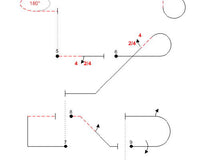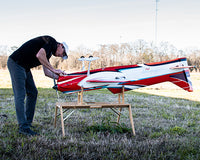This article is written by valued CK Aero contributor Derek Emmett
When I started flying again after a 25 year leave, I was pleasantly surprised at all the changes, but also surprised at some of the lack of information. There are a lot of great products out there for us to use in our RC, but not a lot of information, outside of word of mouth and RCU.
When I came back flying I did what I did in the past and used a single receiver/servo battery pack. Many of us have the attitude that “I never had a failure in the past, so why do anything different?” I personally tend to be a minimalist, or keep it simple kind of guy. However, on my 4th flight attempt with my brand new MythoS, a large investment after all these years, powered by a single battery, I went to power up my receiver and I got no response? I knew the battery was charged, but maybe there was a connection or switch problem? I inspected everything and the switch was on and everything was plugged in, so why wasn’t my receiver powering up? Did my voltage regulator fail? Did I set the plug orientation wrong? I happened to have a digital meter with me, so I checked the output of the regulator and it read 0V? I unplugged my battery to measure it, and sure enough it was 8.1V. I said to myself, “oh, the regulator must have failed, but what are the chances of that?” I plugged the Rx battery back into the regulator, and magically the receiver turned on? What was different now that things are working? With the receiver now working I started to wiggle the power connections, and what I found surprised me! The connection of the battery to the regulator was intermittent. Yes, the part that we tend to take for granted failed me! One of the pins to the battery pack was slightly deformed and not making a tight connection. The pin was defective?! It now became unbelievable that I was putting all my faith into a $15 battery to solely power my $5k investment?! Thankfully I found this issue on the ground and not have the intermittent connection let go during flight. Sorry for the story build up here gang, but now you can see my interest in talking to you about “Redundant Power Systems.”
After my near power connection fatality, I went home immediately and looked for redundant RC power systems. When I asked around the pattern community what folks were doing for redundant power, most said “I don’t use anything”, or “what is redundant power?” Many folks were doing nothing, some were hard wiring two batteries together, un isolated, and calling that “backup power.” I design electronic systems for a living, so electronic principals and information can’t be taken for granted. I realize this thus want to share these ideas to bring a more clear understanding, so that the non techies in our community can make more confidant/informed decisions in their setups.
So what is a redundant power scheme in terms of Pattern? In our case, it is two independent power sources that are isolated (electrically independent) by a voltage threshold monitoring switch device, that outputs power from the highest voltage source. To be “truly redundant” each source can’t be directly traced back to the other source, with respect to the (+) receiver. The switch device makes (-) ground common between the RX and two sources. There are other considerations in our power system, like redundancy switches, ESCs with BECs, and regulating the voltage that gets to the servos and receiver. First, what is regulating voltage and why do we do it? This is a complete discussion in itself, but to simplify the decision process, some things should be considered when regulating your power sources.
- Do you have a “low voltage (4.8-6.0V)” or “high voltage (6.0-8.5V)” System (Receiver/Servos)? For this article I’ll refer to these types as LV and HV Systems. If we are using 2S Lipo’s to power our system, the fully charged 2S settles at ~8.3V. However, LV receivers need 4.8-6.0V, thus a voltage regulator is required. And in the HV system case, you may have choices that reduce complexity and weight!
- Do you have an ESC with programmable BEC (Battery Eliminator Circuit)? The BEC is a regulated voltage source based off the 10S Flight Pack. Some folks are afraid to use the BEC, yet this source is a regulated, filtered low noise power, and lowers system weight when used in place of 2S Lipo’s. There’s also Opto Isolated ESCs, which have no internal BEC, but provide isolation from potential interference caused by the controller. With Opto Isolated ESCs, you must provide an external RX battery source. Any potential interference caused by ESC operation can’t be transferred to the receiver, because of the Opto barrier between input/output signals. These signals have no electrical connection to the Flight Pack battery. And last, we have ESCs with no BEC or Opto Isolation.
- Is constant speed and performance from your servos important? There should only be one answer here in our sport, YES! As a 2S Lipo loses charge, our servos will see a lower voltage, and servo speed/performance is changed. This is why we want to use voltage regulated power, so that our servos see a constant voltage throughout our flights, and performance stays constant. If you use a BEC as your regulator, you can program the output to match your HV or LV system. If you are using 2S Lipo’s (7.4V nominal, 8.4V fully charged) you will use a 6V regulator for LV and a 7.5V regulator for HV systems. If you have telemetry on your radio, you can easily check the status of your RX battery condition. For example, once I see that my RX battery is starting to drop to 7.4V, I swap it out for a fresh battery. Typically I get 10-12 flights out of a 900mAh before it is discharge to 7.4V. Depending on your sequence and the size of the geometries, you may consume 50-70mAh/flight. If I’m using external 2S RX batteries I monitor it so that I’m always operating at the regulated power, and therefore getting consistent servo performance. With programmable regulators or BECs, you have more options, but the above is a good compromise for external Lipo’s.
So what about power isolation devices that switch and maintain output power between two sources? What are those? First, they isolate one power source from another. Second, they always maintain the output of the highest voltage source. Why do we want to do that? If one power source fails or drops out, the secondary source continues to do the job that we need, powering our receiver and servos! If the power sources are not isolated there’s a potential failing point that pulls down the output of the backup source, to failing conditions. Right now many of you might be saying “I have thousands of flights with two different battery backs tied directly together.” Or maybe you’re the guy that runs a single receiver pack and has never had an issue? I call you lucky! Tying batteries directly together provides more capacity, not redundancy. Look at my simple failed case above, or just think for a moment at why not put in a redundant power system in? Honestly, it does cost much, and if one power source happens to fail (battery, cable, regulator, BEC, etc) you are covered! Let’s look at some potential cases that you can easily implement.
Below are some examples of dual power source combinations. Each case assumes you will use some type of redundancy isolation switch; i.e. Jeti DSM ESC, or PowerBox. In these examples, ground is common between the sources and the RX. For example, when using the DSM ESC, Source 1, Source 2, and the output all share common ground. I could not find a schematic of the PowerBox switch, or one to Ohm out, but it likely has grounding configured the same way:
Dual Power Source Options Include:
- Two 550-900mAh 2S Lipo batteries.
- One 2S Lipo and a 2S Tap off the flight pack. *2S Tap requires using balance male connector, and using the low side, ground (-) end of your first 5S pack. You will need pin one ground (-) and pin three to reach your (+7.4V nominal) connection. For safety, remove the 4 unused male pins from Tap plug balance connector.
- One 2s Lipo and the ESC BEC (Uses Flight Pack to generate primary system power).
Each combination above has some considerations that could weigh into your decision process. For example, some redundancy switch devices have built in voltage regulation, and some don’t. Some ESC’s have a built in programmable BEC. Some ESCs have Opto Isolation. Other details include; the Jeti DSM passes throttle data from the input to out, untouched, and the PowerBox does not. This saves cabling. And of course, some of you have LV vs. HV systems.
Let’s look at some of our power/redundancy options in the following chart. Power source options, solution weight, and ease of implementation are relatively measured here. I’m also showing two different redundancy switch devices; PowerBox and Jet DSM ESC. I ran out of time writing this article, and do apologize for not showing any details in my measurement process below.
*Clean means the following: Ease of implementation, less parts, minimum connections, less things to go wrong.
We have some power/redundancy options above! To be fully redundant the power sources need to be independent and isolated and from each other. For example, some folks might want to put two 2S batteries together in parallel, which gives you more capacity and zero redundancy. With power isolation, if one of the power sources fails, the isolation device only outputs power from the higher voltage source. In other words, if one source fails completely, the second source is isolated and unaffected by the primary source failure. Bottom line, we get a chance to land our plane if there is a primary or secondary power failure.
Below I’m showing a possible solution for an HV Redundant System. This ESC has a built in BEC that can be programmed to regulate to your HV/LV settings. The redundancy switch in this case, Jeti DSM ESC, monitors Source 1 and 2, and always outputs the highest source to Vout. Power to the Receiver and throttle data, are past in one cable through the DSM. This lowers your cable count by one! This setup would also support LV systems, but you would need to use an external regulator at Source 1 input. However, PowerBox makes a redundancy switch that has built in dual regulators that support both HV and LV systems.
HV System Block Diagram
The picture below is a redundant setup that has the following features:
- For HV systems (can be modified for LV with regulator at 2S input)
- Redundant power
- External voltage regulator not required.
- BEC is the primary source, set at ~8.1V.
- 2S 550mAh Lipo is the secondary and pit use source. Off the charger this battery will settle to ~8.3V. This source will initially act as my primary source (remember, the voltage monitor always outputs the highest source), due to it being 0.2V above my BEC Vout. However, after a single flight and some pit use, it will fall below the 8.1V BEC setting. At this point it will continue to act as the secondary source until there is a BEC source failure, or the BEC is turned off.
- Advantages: Light weight, minimum components and connections, pit use without flight pack, and throttle connection is passed through DSM (meaning less cables).
I hope this article helps guide some of you in deciding how to power and protect your airplanes! Please feel free to ask me any questions you may have!
Best
Derek…












2 comments
Augustinas Rimkus
Was wondering, in case of DSM failure there would be complete loss of control/power. How about DSM redundancy?
———
CKAero replied:
I’m not Derek, but I can attempt to answer your question!
All dual power switches I know of are built to fail in the “on” position so the possibility of a failure here causing a real issue are pretty minimal. The redundancy discussion can be taken to it’s ultimate conclusion of two airplanes flying side by side with two separate pilots and transmitters but then … What are we really accomplishing 😂. It will always be a case of mitigating risk and in this case, the rx battery is a component with a relatively high risk of failure compared to other parts of your system that play a more passive role.
Thanks for your question!
Brett
Joseph Jones
Just wondering if I could use a Western Robotics Hercules Super Mini G2 Bec. on the Jeti DSM ESC.
Instead of second battery. Thank you.